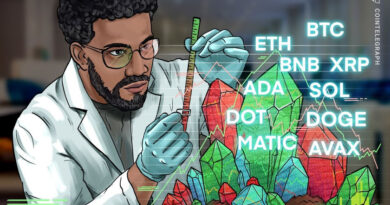Cross-chain money markets, latest attempt to bring liquidity to DeFi
Cross-chain money markets hope to drive liquidity to DeFi for top-performing assets, but will the concept catch on?
Decentralized finance has seen impressive growth throughout 2020. To put this into perspective, a new report from Cointelegraph Consulting shows that the total value locked in DeFi jumped past $6 billion in August while in June, the TVL in DeFi was just over $1 billion, and ultimately stands at $9.4 billion at the time of writing.
While impressive, the DeFi space is still in its infancy, and many hurdles must be overcome before it enters the mainstream crypto market. Many of the challenges currently faced by the DeFi sector revolve around the rise of questionable projects and issues resulting from the Ethereum blockchain network. To date, the DeFi industry is dominated by projects built on Ethereum. While these decentralized applications may be more compatible with exchanges, wallets and stable coins, high gas fees and scalability challenges are hampering growth.
As such, the DeFi sector is beginning to see new platforms built to solve the challenges associated with the Ethereum network while enabling cryptocurrency investors to achieve high yields and growing returns.
The rise of cross-chain money markets
One way investors are capitalizing on DeFi is by lending and borrowing digital assets. While money markets such as Aave and Compound are some of the most dominant platforms for such use cases, new solutions that cater to assets outside the Ethereum ecosystem are being developed.
For example, DeFi platform Kava enables individuals with digital assets to use these as collateral to receive loans. Brian Kerr, the CEO of Kava, told Cointelegraph that the primary use case for Kava’s lending facility is to provide users the ability to get capital for leverage. This enables investors to buy more cryptocurrencies and increase their position size in the assets they want.
Kerr further noted that the next major release of Kava is set for Oct. 15. Known as Harvest.io, this application is built on top of Kava and will enable users to borrow or lend Bitcoin (BTC), XRP, Binance Coin (BNB), Binance USD (BUSD) and other top-performing collateral. According to him, Harvest’s core feature is that it’s interoperable with other networks to provide lending and borrowing of assets that otherwise have no access to DeFi services:
“Harvest is like a DApp on Ethereum that lives on Kava. The only difference is that there are no gas fees, and transactions are much faster. Kava validators can process blocks fast and can leverage things we’ve already built like cross-chain aspects and price oracles.”
Although the concept is very new, Kerr believes there is potential for cross-chain money markets in DeFi. In particular, cross-chain money markets will open up liquidity by allowing top-performing assets such as BTC and XRP to participate in DeFi options. Michael Arrington, a partner at Arrington XRP Capital — a digital asset management firm — told Cointelegraph that XRP holders have indeed been asking for DeFi products: “XRP holders will have DeFi options for the first time ever.”
That being said, the DeFi space can expect to see more cross-chain money market platforms enter the scene. For example, Equilibrium is another interoperable money market platform that allows users to stake and earn, lend, borrow and raise liquidity for digital assets and decentralized stablecoins. Alex Melikhov, the CEO of Equilibrium, told Cointelegraph that the goal behind the project is to address the main hurdles facing the current DeFi market:
“Today’s DeFi market suffers from fragmentation, lack of interoperability, and inefficiency of bad debt liquidation, which resulted in significant losses in MakerDAO protocol in March. Equilibrium will offer true cross-chain interoperability and will expectedly help to reach the market’s full potential.”
Unlike Harvest that is built on top of the Kava blockchain, Equilibrium leverages Polkadot’s Substrate technology, allowing for the creation of their own blockchain that will eventually become a Parachain, which is an integral part of the Polkadot network. According to Melikhov, Equilibrium is not replicating any of the existing Ethereum-based DeFi protocols but will solve the current challenges of scalability and high transaction cost: “The underlying technology has an embedded sharding mechanism and implements various out-of-the-box consensus models.”
Will this drive mainstream DeFi adoption?
Changpeng Zhao, the CEO of the Binance cryptocurrency exchange, told Cointelegraph that while cross-chain money markets are important, these platforms do not seem to be the one factor that will lead the mainstream to embrace DeFi:
“We will carefully monitor how a greater amount of chains building their respective DeFi ecosystem will impact the total locked value across DeFi as a whole. We expect that the TVL will grow in proportion to the market cap of the chain’s native assets. Ultimately, there might be some synergy effects where cross-chain portability and a much broader offering will enable users to find exactly their risk-profile, exactly their service offering, exactly their UI.”
According to CZ, these factors may eventually lead to mainstream adoption or at least mainstream adoption of DeFi by crypto users. However, before this happens, Zhao mentioned that several chains need their own ecosystem, along with cross-chain aggregators that exploit cross-chain arbitrage opportunities and offer a reliable user experience. “For now, the user experience is probably the key barrier to entry for new users in DeFi since fees require gas, having control over the private keys and more,” he said.
Nonetheless, there seems to be a growing demand for cross-chain money markets in today’s DeFi sector. Gerald Votta, the director of communications at Quantum Economics — a digital asset space advisory firm — told Cointelegraph that there are thousands of subtokens for DeFi applications. He noted that cross-chain money markets open this up to XRP, BNB and other coins that have liquidity.
Kerr also remains hopeful, noting that cross-chain money markets are just now emerging and are already showing promising signs: “The potential is massive, but only time will tell how fast we will see adoption.”




